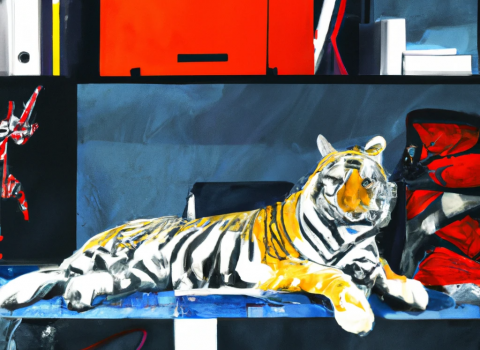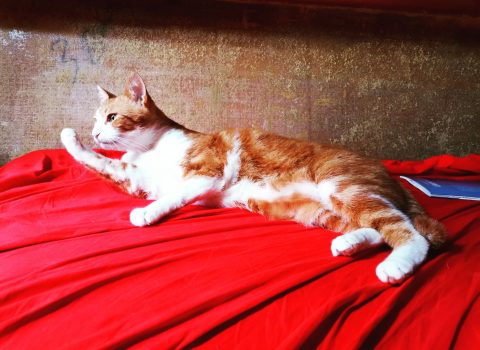- Per info e Contatti
- +39 0547.631068
- info@lamconsulting.it
Is there a tiger in the room?

La Tigre è nella Stanza
27 Gennaio 2024IS THERE A TIGER IN THE ROOM?
How to win your Inner Game
Ferdinando is a highly technically trained General Manager, very communicative and empathetic. As he deeply believes in the importance of well-being, he has initiated an ambitious corporate well-being project. One day, unexpectedly for Ferdinando, his colleague denied him the support he expected. In response to that, Ferdinando bursted with rage and verbally attacked his colleague.
Monica is the key sales person, covering strategic areas such as the Middle East, France, and Russia. She comes across as always positive, bright, and collaborative. However, as the company structure develops, and the owner needs to bring in an external manager as the Sales Director, Monica ceases to be collaborative and she starts to hide information about the market and clients.
Robert is a highly regarded expert in the eyes of all his colleagues. Therefore, he was selected to represent the company for potential investors. Nevertheless, whenever Robert has to face the audience, he experiences a high level of anxiety. As a result, he freezes, words escape him, and he gets visibly agitated. When this happens, he may appear as someone lacking the basic training in the field. .
The director of the corporate department of an important bank is pitting his entire team against the rest of the company. On a daily basis he emphasizes the inefficiency of various other departments.
Amy is known as a keystone for almost everyone in the company due to her meticulousness. However,her perfectionism, has an unpleasant side: when triggered by fear of making mistake or facing criticism for inaccuracy, Amy experiences a severe panic. This happens even in the occasions with insignificant and easily solvable problems.
I described above the situations where ‘automatic’ reactions take over and impair personal skills, including the ability to choose better strategies; sometimes this reactions are mysteriously pushing us to behave in a way that contraddicts our deepest values. I’ll stop here, but I suppose you can add examples from your own experience.
Why we are so irrational
All reactions mentioned above above could be explained through the lens of Polyvagal Theory. Steven Porges, the author of Polyvagal theory, sheds the light on our irrational behaviors. According to Porges our behaviours are closely tighten to the work of our nervous system, whose primary role is to assure our survival.
In order to survive in the world with dangers, we developed three levels of defensive reactions. They are based on three levels of perceived safety/danger level in our environment and inside our body.
The highest perceived level of safety allows us the full access to our resources. Among these resources, a particular role is played by our social skills: we smile, mobilise the facial muscles, calibrate our voice in order to establish connections with others. So when we face a problem, we can find solution in our mind, we can act to solve it, or we can partner with others.
But when our ‘neuroception’ perceives an extreme a threat, one of two other states might kick in: the “fight or flight state” or the ‘shutdown’ state. When we are in those states, our body undergoes sudden changes necessary for it to defend itself. While that happens, cognitive and relational capacity are also affected. Since these two functions are not necessary for survival, they are compromised accordingly. Therefore, we may find ourselves struggling to grasp some nuances of reality, and ultimately, to reason about it. Instead, we enter into a space of a “tunnel vision”, where many pieces of information are simplified or lost, reality becomes rather black or white. Consequently, our decision-making ability becomes somewhat limited. On the relational level, the ability to connect, express emotions and empathise drops as to its irrelevance: we must fight or flee!
The third state I mentioned is shutdown or freeze. As you may guess, as in animal world, in the presence of imminent and extreme threat, the animal prepares to death, and all systems go into shutdown. Have you ever felt unable to speak out of fear and yet couldn’t walk as your legs felt like cotton? This can also happen, and I will explain how these states could be in control for those who are aware.
These unconscious states of our autonomic nervous system facilitate the behaviors that seem excessive, irrational, and inexplicable (especially when they are observed in others). When we manifest them ourselves, we endure them, sometimes end up justifying them, though we are not proud of them.
But there’s no tiger in the room!
When people in an organization respond automatically and have reactions of excessive anger, jealousy, or fear (of being excluded or not being recognized, etc.), their behaviours will not lead to optimal outcomes. Even when one has a good reason to be angry, more often than not his/her behaviour is not particularly efficient. And this is something one has to acknowledge , even if it feels right to be angry.
So, how can we reconcile the dilemma of the necessity of our primitive defences and yet their disfunction in the modern world?
The key is just that the tiger is not in the room.
Our nervous system in those situations is reacting as if there was a real tiger. And the nervous system knows that in those circumstance, things like a splitting hairs philosophy, falling in love, finishing digestion are unnecessary. What would really matter, is that muscles are supplied with blood, heart pumps faster , and breathing allows better oxygenation.
But in the office, we don’t have to run away or get into a physical fight with someone (presumably). And so, all that potential becomes pretty useless. Simultaneously, and unfortunately, in those states we also lose the ability to access resources we actually need.
It’s as if our nervous system reacts to a tiger, but the tiger isn’t there. Hours later, we come back home in the evening with all that tension in the body that we haven’t been able to release. Today, there is scientific evidence that excessive cortisol in the long run compromises our health.
But why does our nervous system, which is tailored to assure adaptation , have such an ineffectivet response?
The tiger is truly in the room
We could answer this question by saying that, in fact, the tiger IS in the room. However, one must know how to see it. The tiger exists in a form of our past experiences, related to the time of our lives when certain stimuli were a serious threat. If my nervous system goes into override when a person next to memove his eyebrows in a certain way, it might be, for instance, because that look reminds my nervous system the way my father looked when he threatened to leave the house. And at that age abandonment is life threatening for human offsprings. So, the nervous system cognised it as a “tiger”. When a similar behavior is perceived in the adulthood the nervous system reads it as it was the same threat. Therefore, the same reaction is triggered (of fear, or anger to protect myself and so forth). The fact that I am a self sufficient adult does not matter. Very often we are not even aware of that mechanism: it happens unconsciously.
It is important to recognise that anything can be a trigger: a uniform, a specific request, a ‘no’, a smell, a time of the day, when night falls, a noise, a tone of voice, or even a melody. It only depends on what has been perceived, and cognised as threat.
What can we do?
Our Inner Game of Leadership program is tailored for individuals and teams in order to modify these reactions. The mastery of this skill comprises three steps or levels:
- Awareness. The more we become aware of these mechanisms and what triggers them, the more we can prepare ourselves, and perhaps, avoid the unwanted reaction over time. Awareness alone does not change reactions, but facilitates conditions for a change. It is a necessary step to access the next levels.
- The second level is the development of flexibility of the nervous system. In our program, we explain and facilitate the reset and retraining for the nervous system to recover quickly from the defensive states (ight or flight, shutdown or freeze), and to return to a resourceful state. Flexibility allows a reasonably fast return to homeostasis when we are triggered
- A third level consists in modifying the reactions themselves. It means integrating neural circuits responsible for our reactions into new connections. Allegorically speaking, our inner child becomes reassured he/she is no longer in danger, he/she is safe now.
Can this subtle and personal work be addressed at the workplace?
Our inner world, often presented by our unconscious reactions and other legacies of the past, is often viewed as a deeply private matter, or even a weakness to perhaps be ashamed of. I believe there is a reason behind these highly defensive views. If I was to give it a voice in a context of our work, I would ask: where shall we draw the line in our intervention? Or to what extent shall we expect people to share their personal experiences in a corporate space? Even, when does it become a kind of group psychotherapy?
These are reasonable questions and should be addressed. Boundaries ethics must be taken very seriously. In order to follow them, let’s clarify some of our basic assumptions. In our trainings we assume the following:
- The intervention does not aim to perform any sort of psychotherapy. We work on reactions that are not in the realm of psychotherapy but on the contrary are defined by the group as impacting the business health.
- We bring all this internal work to two areas of development: a) how the inner tiger can affect our ability to access our resources, skills, cognitive and relational abilities in order to be more effective, and b) how the inner tiger can be used to increase the group’s cohesion, committment, collaboration and accountability towards business goals.
- Training is progressive. We engage people to train their awareness and flexibility starting with meaningful but easy reactions. Then we progress at the participant’s pace.
- Everyone is free to share or not share personal information;
- During the group training each person deals with his/her own Inner Game. For instance in a situation of conflict, , each party takes care of what’s going on inside of him/herself and don’t take responsibility for changing the other’s reaction;
Conclusion
It’s already been few decades since the corporate world started to follow and apply tools developed by neuroscience. Modern leaders’ culture includes a consistent work on self development. Addressing one’s vulnerabilit is no longer seen as a sign of weakness. The view of it as of something embarrassing is outdated. On the contrary, it is largely seen as strength and desirable trait for managers, especially when (as a result) it allows them to be more authentic and free of self-sabotage.
Leaders are starting to understand that getting better at their ‘Inner Game’ is the way, a necessary declaration of openness to one’s own and others’ humanity. As a result of applying these principles, we observe the increased group cohesion. The Inner Game becomes a new framework and a language for our corporate clients.
Certainly, there still are resistant corporate subcultures that lean towards old fashioned brushing-under-the-rug approach, where personal matter (for example, earlier we were talking about unconscious reactions) is not seen as appropriate to discuss in the corporate space. But I believe there is a fundamental error at the core in that approach. These reactions do not disappear if we don’t talk about them. On the contrary: the less aware we are of them, the more we endure them. The more we try to push them out of the window, the more the tigers come back in through the door.




